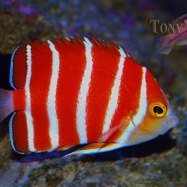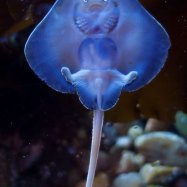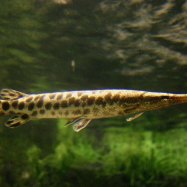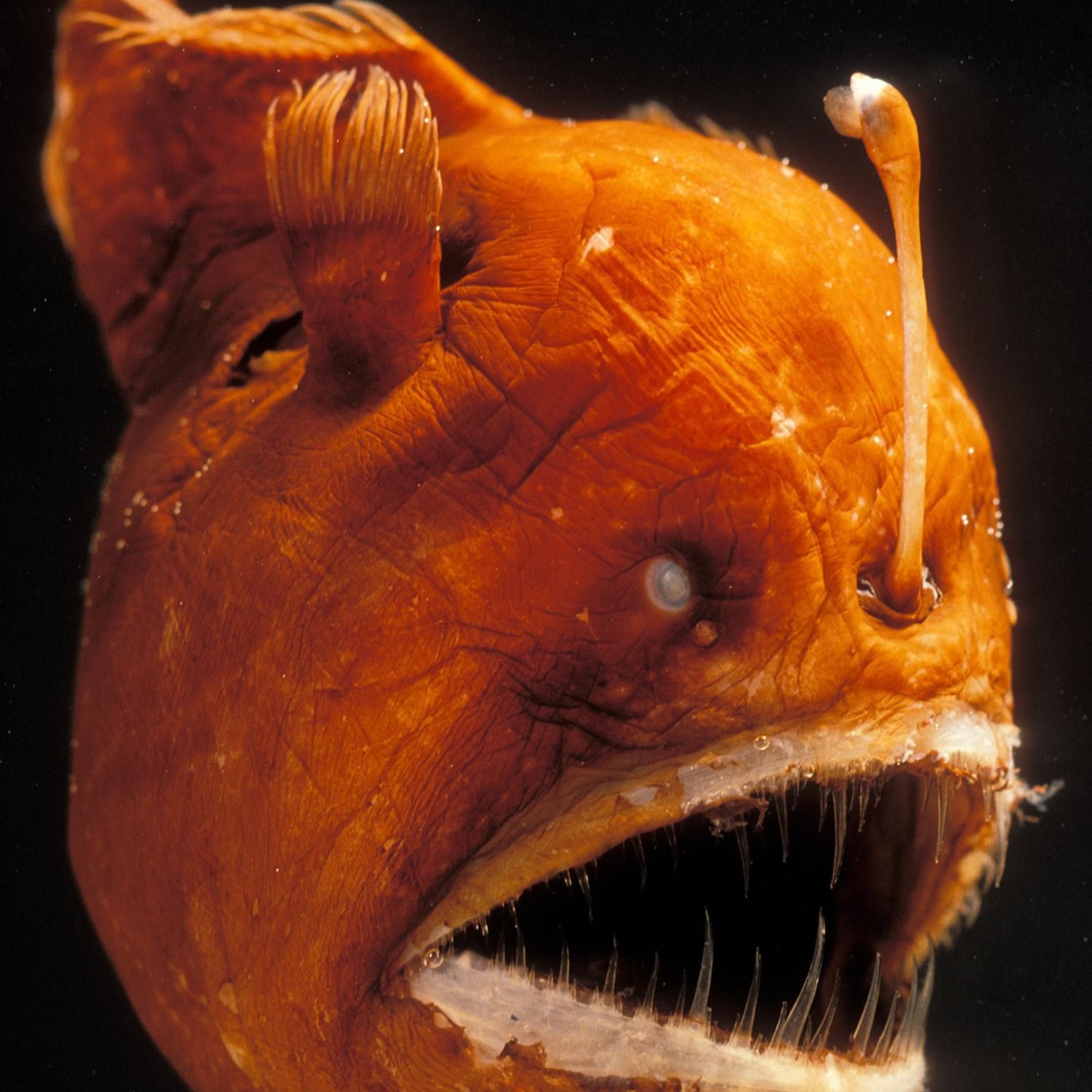
Anglerfish
Up to 3 feet (1 meter)
Meet the bizarre Anglerfish, a deep-sea dweller with a unique body shape of a bulbous body, large head, and wide mouth. These creatures can grow up to 3 feet long and belong to the Melanocetidae family. Found in the ocean, they use a glowing lure to attract prey, making them a fascinating but fearsome predator. #Anglerfish #DeepSeaCreatures #OceanLife
Animal Details Summary:
Common Name: Anglerfish
Kingdom: Animalia
Habitat: Deep-sea
The Mystical World of the Anglerfish: Nature's Deep-Sea Masterpiece
Deep in the depths of the ocean, in the vast and dark unknown, lives a creature that is as fascinating as it is elusive. It is a creature that has captured the imagination of marine biologists, divers, and nature lovers alike - the Anglerfish, also known as Melanocetus johnsonii.This remarkable fish has earned its place as one of the most intriguing creatures of the deep-sea. With its unique features and enigmatic behavior, the Anglerfish is a true masterpiece of nature Anglerfish. In this article, we will take a deep dive into the world of this mysterious creature, exploring its taxonomy, habitat, feeding methods, and more.
Taxonomy: Unraveling the Relationship of Anglerfish
In order to truly appreciate and understand the Anglerfish, we must first take a closer look at its taxonomy. The Anglerfish belongs to the kingdom Animalia, which means it is a multicellular eukaryote that obtains its energy by consuming other organisms. Its phylum is Chordata, which means it has a flexible structure, a primitive nervous system, and gill slits. The class of the Anglerfish is Actinopterygii, which includes all ray-finned fishes. This class of fish represents the largest and most diverse group of vertebrates on Earth.The Anglerfish also has a designated order - Lophiiformes. This group includes all the various types of anglerfish, such as deep-sea anglerfish, goosefish, monkfish, and batfish. Within this order, the Anglerfish belongs to the Melanocetidae family, a group of deep-sea anglerfish that are characterized by their large heads and wide mouths Admiral Butterfly.
Habitat: Exploring the Dark and Mystical Depths
The Anglerfish is a deep-sea creature, which means it inhabits the oceans at a depth of at least 200 meters (656 feet). However, some species have been found as deep as 2,000 meters (6,560 feet) below the surface. These deep-sea zones are characterized by a lack of light, high pressure, and extreme temperatures. In fact, the temperature in these depths is close to freezing, making it a harsh and inhospitable environment for most marine life.While the exact geographical distribution of the Anglerfish is not known, they have been found in all major oceans around the world. They are most commonly found in the Atlantic, Pacific, and Indian Oceans. Due to their deep-sea habitat, it is difficult to determine their specific country of origin. However, they are believed to be widespread and can be found in many coastal regions around the globe.
Feeding Method: The Art of "Sit-and-Wait" Predation
One of the most fascinating features of the Anglerfish is its unique feeding method. Unlike most fish, which actively swim to hunt for prey, the Anglerfish uses a highly specialized, passive feeding strategy known as "sit-and-wait" predation. This means that they find a suitable spot and stay in one place, waiting for their prey to come to them.The Anglerfish has a bulbous body with a large head and a wide mouth, which serves as a trap for unsuspecting prey. It has a hinged jaw that allows it to open its mouth incredibly wide, consuming prey that is much larger in size than itself. Additionally, the Anglerfish has a long filament-like structure called an esca, which is attached to the top of its head. This structure emits a bioluminescent light that acts as a lure for its prey.
The Anglerfish mainly feeds on small fish, squid, and crustaceans. However, some species of Anglerfish have been known to consume larger prey, such as sharks and whales. The ability to lure in prey and consume food that is much bigger in size than its own makes the Anglerfish a formidable predator of the deep-sea.
An Animal of Mystery: Varies Based on Species
The Anglerfish is a one-of-a-kind creature in many aspects, and its appearance is no exception. It is commonly perceived to have a large head, a wide mouth, and a unique filament on its head. However, the appearance of Anglerfish can vary greatly based on the species.Some species of Anglerfish have a slender and elongated body, while others have a more rounded and compact body. Their coloration also varies, with some species having a dark or transparent body, while others have bright colors and patterns. This variation in appearance is believed to help them camouflage and adapt to their specific environments, making them less vulnerable to predators.
The Size: Not Your Average Fish
The Anglerfish may look like your average-sized fish in pictures, but in reality, it is much larger and more impressive in size. While the exact length of Anglerfish can vary based on the species, they can grow up to 3 feet (1 meter) in length. This is significantly larger than most fish found in the deep-sea, where fish tend to be smaller in size due to the lack of food and the extreme conditions.In Conclusion: A Remarkable Creature of the Deep-Sea
The Anglerfish is a unique and remarkable creature that continues to amaze and intrigue researchers and nature enthusiasts alike. From its taxonomy to its feeding methods, the Anglerfish is a fascinating subject that deserves our attention and respect.As we continue to explore and study the oceans, we are bound to come across more discoveries and information about this elusive creature. The Anglerfish, with its captivating features and mysterious nature, is a true masterpiece of nature and a testament to the wonders of the deep-sea.

Anglerfish
Animal Details Anglerfish - Scientific Name: Melanocetus johnsonii
- Category: Animals A
- Scientific Name: Melanocetus johnsonii
- Common Name: Anglerfish
- Kingdom: Animalia
- Phylum: Chordata
- Class: Actinopterygii
- Order: Lophiiformes
- Family: Melanocetidae
- Habitat: Deep-sea
- Feeding Method: Sit-and-wait predator
- Geographical Distribution: Worldwide
- Country of Origin: Not applicable
- Location: Ocean
- Animal Coloration: Varies based on species
- Body Shape: Bulbous body with a large head and a wide mouth
- Length: Up to 3 feet (1 meter)
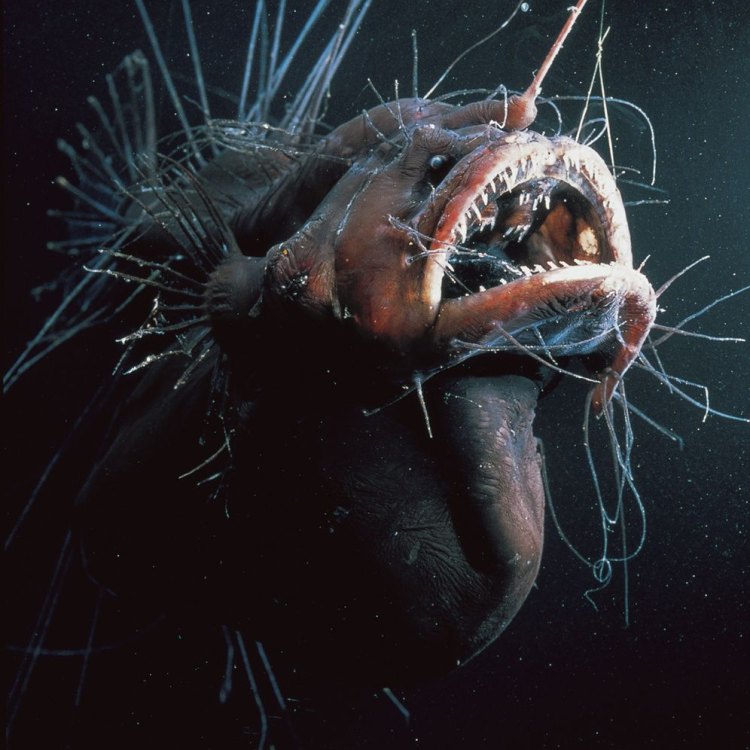
Anglerfish
- Adult Size: Varies based on species
- Average Lifespan: Unknown
- Reproduction: Sexual reproduction
- Reproductive Behavior: Parasitic mating
- Sound or Call: Not applicable
- Migration Pattern: Not applicable
- Social Groups: Solitary
- Behavior: Aggressive and territorial
- Threats: Habitat destruction and overfishing
- Conservation Status: Data Deficient
- Impact on Ecosystem: Important predators in deep-sea ecosystems
- Human Use: Some species are caught for commercial purposes
- Distinctive Features: Bioluminescent lure on the head, large mouth, and sharp teeth
- Interesting Facts: Female anglerfish are much larger than males and often have multiple males fused to their bodies.
- Predator: Large deep-sea predators
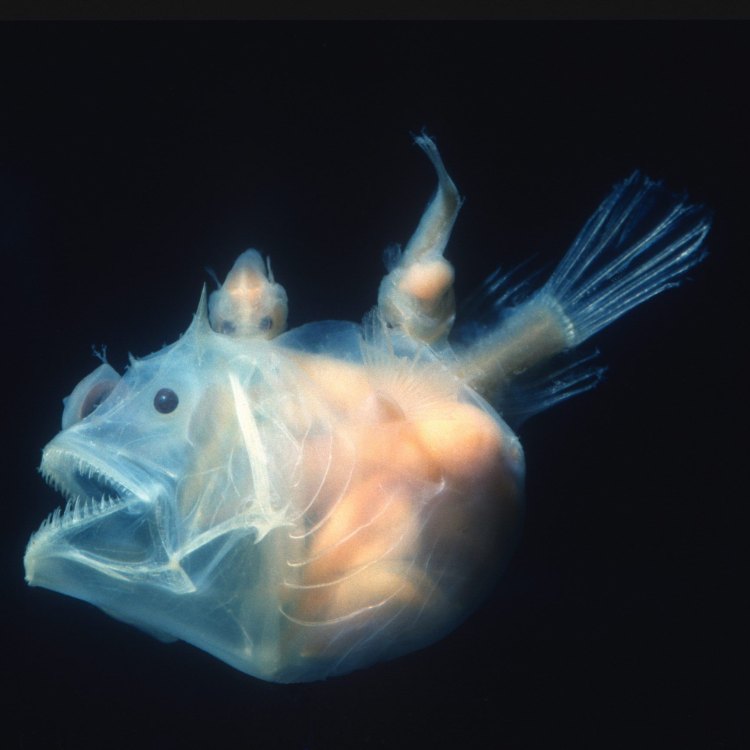
Melanocetus johnsonii
The Fascinating World of Anglerfish: The Ultimate Deep-Sea Predator
Deep beneath the surface of the ocean, in the dark and mysterious depths of the abyss, lives one of the most captivating creatures of the sea - the Anglerfish. Known for its unique physical characteristics and unusual reproductive behavior, this elusive species has captured the imaginations of scientists and curious minds alike.With a distinctive bioluminescent lure on their heads, large mouths filled with sharp teeth, and a parasitic mating strategy, anglerfishes have become a popular subject of study and fascination. In this article, we will dive into the world of anglerfish and discover the mysteries and wonders that surround this fascinating deep-sea predator PeaceOfAnimals.Com.
Unveiling the Physical Characteristics of Anglerfish
The Anglerfish is not just one type of fish, but rather a family of roughly 200 different species that belong to the order Lophiiformes. These slim and small fishes are typically found in the deep-sea areas of the Atlantic and Antarctic oceans, as well as the Indo-Pacific region.One of the most intriguing aspects of anglerfish is their wide range of sizes and shapes. While some species are only a few centimeters in length, others can grow up to a few feet. In general, the size of an anglerfish varies based on its species, habitat, and diet.
Due to their deep-sea habitat, scientists have not been able to determine the average lifespan of an anglerfish. However, some estimates suggest that they can live up to several decades, making them one of the longest-living fishes in the ocean.
The reproductive behavior of anglerfish is another fascinating aspect of their physical characteristics. Unlike most fish that reproduce by external fertilization, anglerfish engage in sexual reproduction Ape. However, their mating process is quite unique and parasitic in nature.
The Mysterious Reproductive Behavior of Anglerfish
Anglerfish are infamous for their unusual method of reproduction, termed parasitic mating. This phenomenon occurs when a smaller male anglerfish latches onto a larger female and fuses with her body. The male then becomes a permanent parasite of the female, living off her blood supply and providing sperm for fertilization.This reproductive behavior is mainly due to the difficulty of finding a mate in the deep-sea. With low visibility and scarce numbers, male anglerfish rely on their keen sense of smell to locate a female. Once they find a potential partner, they must act quickly to fuse with her before other males do.
What's even more intriguing is the size difference between male and female anglerfish. While females can grow up to several feet in length, males are significantly smaller, usually only a few inches. This size difference is essential for the anglerfish's parasitic mating strategy, as the male needs to be small enough to fuse with the female seamlessly.
Exploring the Behavior of Anglerfish
The behavior of anglerfish is equally as fascinating as their physical characteristics and reproductive behavior. Being solitary creatures, anglerfish spend most of their time alone, swimming around the depths of the ocean. They are incredibly territorial and aggressive, often attacking any other creatures that invade their space.One of the most notable behaviors of anglerfish is their ability to use their bioluminescent lure as a form of communication and hunting. The glowing appendage on their heads acts as a bait and attracts prey towards them. It also helps them communicate with other anglerfish and potential mates in the dark.
Another interesting behavior of anglerfish is their ability to camouflage themselves within their environment. Most species have a dark coloration that helps them blend in with the deep-sea, making them nearly invisible to predators and prey alike.
The Threats and Conservation Status of Anglerfish
Unfortunately, like many other marine species, anglerfish face several threats in their natural habitat. Habitat destruction due to deep-sea mining and overfishing has significantly impacted their populations. Additionally, due to their long lifespan and slow reproductive cycle, anglerfish are particularly vulnerable to overexploitation.Currently, the conservation status of anglerfish is listed as Data Deficient by the International Union for Conservation of Nature (IUCN). This means that there is not enough data to determine their population size and trends accurately. It highlights the urgent need for further research and conservation efforts to protect this unique deep-sea predator.
The Impact of Anglerfish on Ecosystems and Human Use
Despite their small size and elusive nature, anglerfish play a crucial role in deep-sea ecosystems. As top predators, they help control the population of their prey, ensuring a balanced ecosystem. They are also a vital food source for larger marine animals, such as sharks and whales.In terms of human use, some species of anglerfish are caught for commercial purposes. In particular, the black anglerfish is highly prized for its tasty meat and is a popular delicacy in some countries. However, their slow reproductive cycle makes them susceptible to overfishing, and proper management measures must be taken to ensure their sustainability.
The Distinctive Features and Interesting Facts of Anglerfish
We have already discussed some of the unique features of anglerfish, such as their bioluminescent lure and parasitic mating behavior. However, there are a few more distinctive features that are worth mentioning.Anglerfish have a large mouth filled with sharp teeth, allowing them to consume prey that is larger than themselves. They also have a flexible stomach that can expand to accommodate large meals. This feature enables anglerfish to survive in the deep-sea, where food sources can be scarce and sporadic.
Now, onto some interesting facts about anglerfish. As mentioned earlier, female anglerfish are significantly larger than males. What's even more fascinating is that they can have multiple males fused to their bodies. These small males practice a form of polygamy, providing sperm to the female and increasing their chances of reproduction.
Predators and Survival of Anglerfish
You might think that as top predators, anglerfish have no natural enemies. However, in the deep-sea, things are quite different. Larger deep-sea predators, such as sharks and whales, can prey on anglerfish. Some bottom-dwelling fish and cephalopods also pose a threat to the survival of anglerfish.To protect themselves, anglerfish have developed various adaptations, such as their camouflage and their bioluminescent lure. These unique features not only help them hunt but also protect them from predators.
In Conclusion
To the untrained eye, anglerfish may seem like strange and scary creatures. However, upon closer inspection, we find that they are incredibly fascinating and vital to the deep-sea ecosystem. From their unique physical characteristics to their strange reproductive behavior, anglerfish have captured the attention of scientists and marine enthusiasts worldwide.Unfortunately, due to habitat destruction and overfishing, the future of anglerfish is uncertain. It is our responsibility to protect and conserve these intriguing creatures, ensuring their survival for generations to come. Let us continue to explore and learn about the hidden world of anglerfish and appreciate their unique beauty and importance in our oceans.
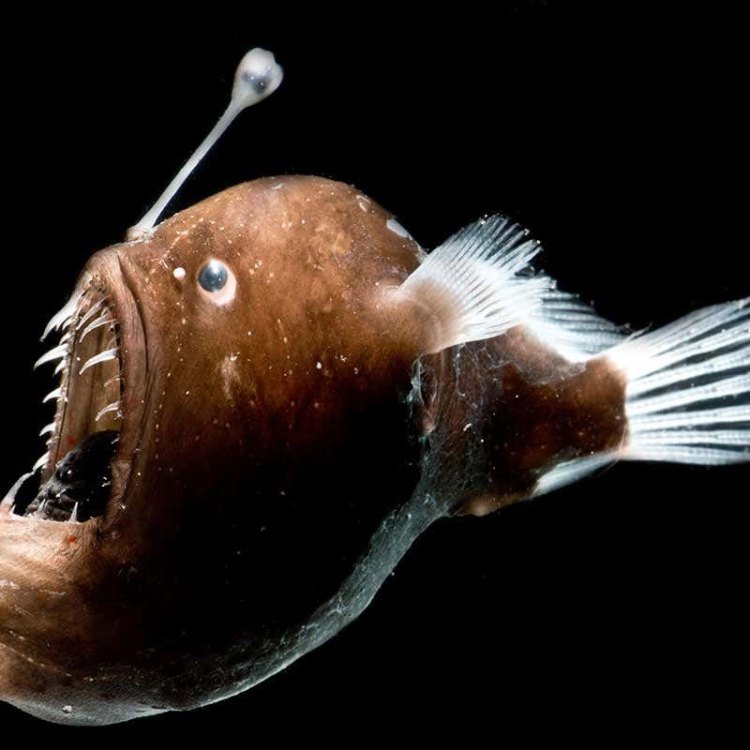
The Mystical World of the Anglerfish: Nature's Deep-Sea Masterpiece
Disclaimer: The content provided is for informational purposes only. We cannot guarantee the accuracy of the information on this page 100%. All information provided here may change without prior notice.

